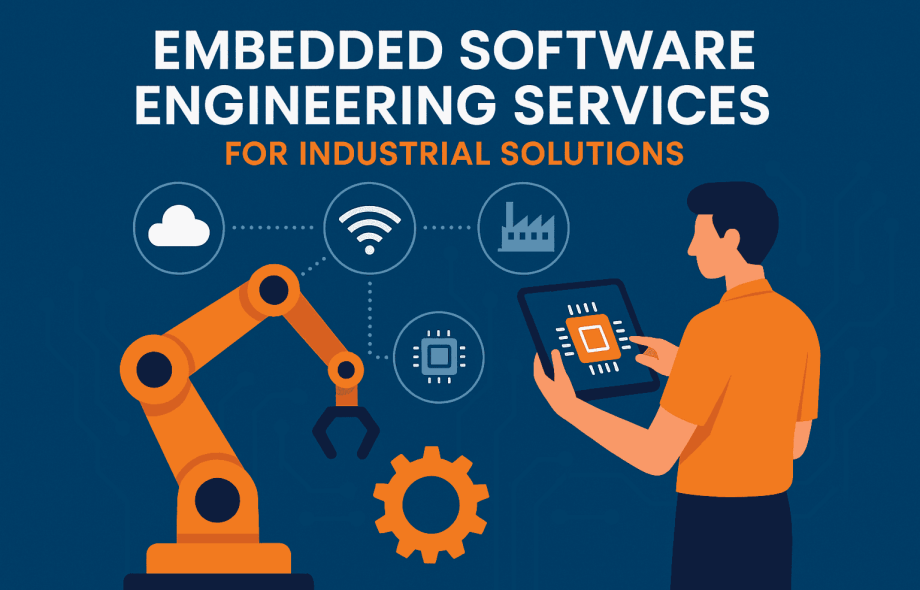Modern factories run on data, speed, and safety. Machines now speak to each other and report their own health. All this is possible because tiny computers hide inside pumps, robots, and control panels. These tiny computers run special code called embedded software. Getting that code right is hard. Embedded Software Engineering Services for Industrial Solutions give plant owners and OEMs a safe way to build smart, strong, and cost-saving systems.
1. What Is Embedded Software in Industry?
Embedded software is a program that lives inside a device. It lives on chips, not on desktop PCs. In an industrial motor drive, it reads sensor data, checks limits, and sends commands. It must be stable in heat, dust, and power noise. It must work for years with no crash. In short, it is the brain of every smart machine on the factory floor.
2. Why Industrial Firms Need Engineering Services
Most plants focus on output and safety, not on deep coding skills. Even equipment makers may lack experts in every new field like edge AI or 5G. Embedded software engineering services fill this gap. They bring skilled teams, test labs, and proven steps. They handle design, coding, and validation. This lets industrial firms stay on schedule and avoid costly bugs.
3. Core Areas of Service
System Architecture
Engineers define how sensors, processors, and networks fit together. They map safety needs and timing limits.
Firmware Development
They write low-level drivers and control loops. Code is lean and real-time.
Communication Stacks
Industry uses many bus types such as CAN, Modbus, EtherCAT, and OPC UA. Service teams add these stacks and test cross-talk.
Security Layers
They lock down boot code, encrypt data, and manage keys. Secure design wards off plant hacks.
Hardware-in-the-Loop Testing
Real signals run through the code in the lab. Bugs appear early, before field trials.
Certification Help
Many devices need IEC 61508, ISO 13849, or UL marks. Service teams prepare packets and handle audits.
Maintenance and OTA Updates
Plants need fast patches. Good partners set safe, staged rollouts that do not stop lines.
4. Benefits for Industrial Operations
Higher Uptime
Stable code cuts unplanned stops. Predictive logic warns staff before faults get big.
Better Safety
Certified software meets strict rules. It lowers the risk of injury and fines.
Energy Savings
Smart drives adjust speed. Sensors turn off idling gear. Small tweaks save big power bills.
Flexibility
Modular firmware lets plants add new sensors or lines. No need to replace full systems.
Lower Total Cost
Outsourcing saves on full-time hires, lab gear, and long bug hunts. Time-to-market drops, so new machines sell sooner.
5. Real-World Use Cases
Predictive Pump Control
A water plant added pressure and vibration sensors to old pumps. Embedded software now tracks patterns. It warns staff ten days before a seal fails. Downtime fell by 30 percent.
Robotic Welding Cells
An automotive line moved to EtherCAT for tight timing. Service engineers wrote custom motion code and safety checks. Cycle time dropped two seconds per panel.
Smart HVAC in Food Storage
Microcontrollers adjust fans and chillers by reading CO₂ sensors. Firmware includes remote OTA updates. Energy use dropped 18 percent and spoilage dropped too.
Wind Turbine Monitoring
Edge devices on tower tops run tiny AI to spot blade stress. They send alerts over 5G. Crews fix small cracks early, saving big replacement costs.
6. How to Pick a Strong Service Partner
-
Industrial Track Record – Ask for case studies in similar gear or standards.
-
Process Rigor – Look for ISO 9001, ASPICE, or CMMI methods.
-
Safety and Security Skill – They should know SIL levels and secure boot.
-
Lab Assets – Scope, climactic chambers, and HIL rigs are key.
-
Clear Communication – Weekly demos, shared boards, and open bug lists save time.
-
Long-Term Support Plan – Confirm OTA tools, hot-line help, and patch SLAs.
7. Common Pitfalls to Avoid
Ignoring Certification Early
Fixing safety gaps late costs months. Plan for rules in sprint one.
Scope Creep
Start with core needs. New features can join once base control is solid.
Weak Cyber Defense
Old field buses were closed. Now plants are online. Build encryption and role checks from day one.
Poor Part Choice
Pick chips with long life and second sources. Avoid redesign when parts vanish.
8. Future Trends in Industrial Embedded Software
Edge AI
Tiny neural networks will spot defects on the line in real time.
Time-Sensitive Networking (TSN)
Ethernet will get deterministic timing once only found in field buses.
Private 5G
Plants will run their own 5G cells for high-speed, low-latency control.
Digital Twins
Real-time models will mirror each machine. Firmware will feed twins and receive tweak rules.
Energy Harvesting Nodes
Battery-free sensors will gain power from heat or vibration, lowering upkeep.
Conclusion
Smart factories need smart code. Embedded Software Engineering Services for Industrial and Business Solutions turn mechanical workhorses into data-driven assets. They boost uptime, cut risk, and spark new savings. By choosing a skilled partner, plant leaders and OEMs can launch safer, faster, and greener machines. The result is clear: lower costs, higher output, and a future-ready industrial edge.


 :
: